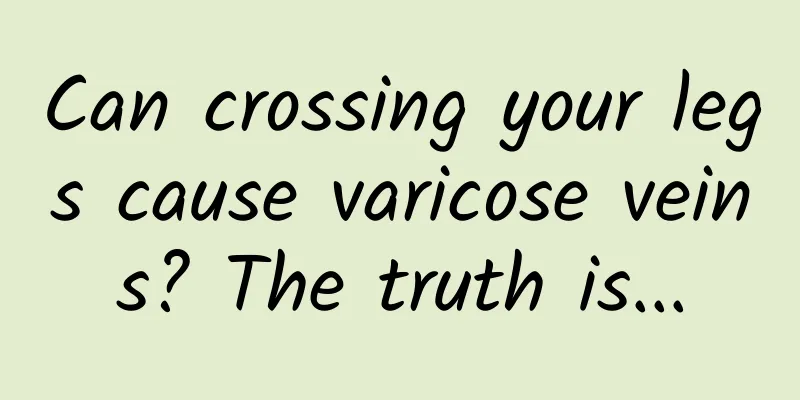Can crossing your legs cause varicose veins? The truth is...

|
Myth: "Crossing your legs can cause varicose veins!" There are rumors online that "crossing your legs can cause varicose veins", which causes panic among many people who usually cross their legs. Rumor analysis: This statement is too absolute and exaggerated. Crossing your legs will not directly cause varicose veins, but if you already have varicose veins, crossing your legs will aggravate the condition. There is a saying on the Internet that "crossing your legs can cause varicose veins". Is this true? Let's talk about it today. Copyright images in the gallery. Reprinting and using them may lead to copyright disputes. How do varicose veins develop? To answer the question of the relationship between crossing your legs and varicose veins, let us first understand varicose veins. Varicose veins are a common disease that affects people's quality of life. Its formation is a complex process involving the interaction of multiple factors such as genetic factors, abnormalities in vascular wall structure and function, and extracellular matrix. Genetic factors play an important role in the pathogenesis of varicose veins. People with a family history of varicose veins are more likely to develop the disease. Studies have shown that if both parents are healthy, the risk of varicose veins is 20%. If one parent is sick, the risk of varicose veins is 25%~62%. If both parents are sick, the risk of varicose veins is 90%. Abnormalities in the structure and function of the vascular wall are also key factors in the development of varicose veins. In the vascular walls of patients with varicose veins, changes in the histopathological phenotype can be observed, including reconstruction of the vascular wall and remodeling of the structure. These changes may be related to abnormal regulation of cell proliferation and apoptosis processes, resulting in decreased elasticity and strength of the vascular wall. In addition, the composition and function of the extracellular matrix (an important component that maintains the structure of the blood vessel wall) may also change, affecting the blood vessel's pumping function and causing blood stasis. Local hypoxia is another important factor, which may occur due to the accumulation of blood in the diseased veins, leading to adaptive changes in the blood vessel wall cells. At the same time, chronic inflammatory response may play a driving role in the development of varicose veins, and the infiltration of inflammatory cells and the release of inflammatory factors may lead to further damage to the blood vessel wall. Changes in hemodynamics, including changes in blood flow rate and pressure, may also affect venous valves and blood vessel walls, contributing to the formation and development of varicose veins. In addition, abnormalities in vasodilation and vasoconstriction may also play a role in the formation of varicose veins, affecting the normal tension of blood vessels and blood flow. Genetic polymorphisms, such as variations in the FoxC2 gene, may also affect an individual's susceptibility to varicose veins. These genetic variations may lead to abnormal expression of certain key proteins in the blood vessel wall, thereby affecting the structure and function of the blood vessel wall. In addition, some lifestyles do significantly increase the risk of varicose veins, such as obesity, multiple pregnancies, long-term standing and sitting. These factors increase the pressure of the lower limb veins, affect the normal function of the valves, and lead to blood reflux obstruction, thus causing varicose veins. In addition, smoking and drinking also increase the risk of varicose veins. The role of crossing your legs in varicose veins Being in one position for too long without adequate muscle activity, combined with the effects of gravity, can increase venous pressure in the lower extremities, significantly affecting the one-way valves in the lower extremities. This can eventually weaken or damage the valves, impair hemodynamics and increase venous stasis, which can lead to varicose veins through venous dilation or blood backflow. The study found that the risk of varicose veins for standing for more than 4 hours a day is 2.8 times that of less than 4 hours. Another study also found that as the standing time increases, the incidence rate of 3-4 hours increases significantly, and nurses who stand for 4-5 hours a day are almost certain to suffer from varicose veins; and they also found that the incidence rate of varicose veins increases by nearly 27 times for every additional hour of standing time. Reference [4]: Prevalence of varicose veins among nurses who stand for several hours per day But generally speaking, people will not cross their legs for such a long time without moving, and there is currently no research to prove that crossing the legs will directly lead to varicose veins in the lower limbs, so people who have the habit of crossing their legs do not need to panic or be too anxious. However, it is worth noting that although varicose veins will not directly cause varicose veins, it may compress the veins, thereby affecting blood circulation and causing venous return to become more difficult. If varicose veins already exist at this time, it will aggravate the condition. How to prevent varicose veins? To prevent varicose veins, you can start by changing those risk factors that can be changed. The following 6 points can be used as a reference: 1. Regularly do 15 to 20 minutes of exercise, such as jogging or cycling, to improve blood circulation and strengthen leg muscles; 2. Use a footrest or footstool to regularly elevate your legs at work and at home to help improve blood flow; 3. Maintain an ideal body weight, as excess weight puts pressure on the groin and thighs, weakening the blood vessel walls in the legs and thighs; 4. Try to avoid wearing high heels for a long time, as they restrict blood flow to the ankles and may affect the pumping mechanism of the large veins in the calves and feet, while low-heeled shoes help improve blood circulation and strengthen muscles; 5. Eat a high-fiber, low-salt diet, because fiber intake can reduce constipation, while a high-salt diet may cause venous swelling; 6. Maintaining a healthy lifestyle, such as quitting smoking, limiting alcohol intake, maintaining a proper weight and avoiding standing or sitting for long periods of time, and occasionally moving around and changing your posture can also effectively prevent varicose veins. Looking in the mirror of rumors This type of rumor is a typical "simple attribution" rumor in the health field. Complex health issues are often simplified to "a certain action" or "a certain food" directly causing a certain disease, ignoring other important influencing factors. It seems reasonable, but it is actually unreliable. To identify and deal with such rumors, you can start from the following aspects: Learn basic health knowledge: Understand the causes and prevention of common diseases and improve your ability to identify them. Multi-channel verification: Confirm the authenticity of information through multiple verifications before dissemination. It is a good thing to pay attention to health issues, but we must also be scientific and rational to avoid being misled. References [1]Fan CM. Venous pathophysiology. Semin Intervent Radiol. 2005;22(3):157-61. [2]Jacobs BN, Andraska EA, Obi AT, Wakefield TW. Pathophysiology of varicose veins. J Vasc Surg Venous Lymphat Disord. 2017;5(3):460-467. [3]Ahti TM, Mäkivaara LA, Luukkaala T, et al. Lifestyle factors and varicose veins: does cross-sectional design result in underestimate of the risk? Phlebology. 2010;25(4):201-6. [4]Shakya R, Karmacharya RM, Shrestha R, et al. Varicose veins and its risk factors among nurses at Dhulikhel hospital: a cross sectional study. BMC Nurs. 2020;19:8. [5]Yun MJ, Kim YK, Kang DM, et al. A Study on Prevalence and Risk Factors for Varicose Veins in Nurses at a University Hospital. Saf Health Work. 2018;9(1):79-83. [6]Kendra Kamlitz. 6 varicose vein myths debunked. 2022. https://www.mayoclinichealthsystem.org/hometown-health/speaking-of-health/6-varicose-vein-myths-debunked [7]Gawas M, Bains A, Janghu S, et al. A Comprehensive Review on Varicose Veins: Preventive Measures and Different Treatments. J Am Nutr Assoc. 2022;41(5):499-510. Author: Jiang Yongyuan, Master of Internal Medicine, Third Military Medical University Reviewer: Tang Qin, Director of the Science Popularization Department of the Chinese Medical Association, National Health Science Popularization Expert |
>>: The "final boss" of the movie "Jurassic World" turns out to be this!
Recommend
Tips for creating hit products!
Whether a product is good or not is not determine...
New ideas for O2O development: Subsidy competition in the first half of the year and layoffs in the second half of the year
[[149898]] Summer has passed, but O2O has not yet...
iOS14.7 official version released! Battery life extended, heating issues significantly improved
[[412242]] Just this morning, Apple officially pu...
TrendForce: Global sales of new energy vehicles reached 2.4 million in 2020, a 19.8% increase against the trend
According to statistics from TrendForce's Tre...
Free Qianjiang Road March 2022 Courses
Free Qianjiang Road March 2022 course resources i...
Evergrande’s new layout, is Xu Jiayin interested in Jia Yueting’s land rather than electric cars?
After saying goodbye to Sun Hongbin, Jia Yueting ...
A day “tethered” by short videos
With the rapid development of short videos, the u...
Pollen season is coming early, pay attention to distinguish between allergies and colds, especially these people
Review expert: Peng Guoqiu, deputy chief physicia...
Still eating and drinking as you please? Be careful to "pick" out colon cancer...Have you fallen into these eating habits?
Our physical health is closely related to our eat...
"I heard that young people have started to raise mango pits?!" What is this joke?
Summer vacation is the season when a large number...
Nexus and compact cameras couldn't save HTC from rapid decline
HTC released a number of new products in New York...
Mini Program Optimization Suggestions
Currently, the mini program optimization suggesti...
Huanwang Technology Annual Review: Fulfilling social responsibility, shining "billions" of screens help the industry move forward
In a blink of an eye, 2020 is coming to an end. D...
Traffic generation solutions such as Zhihu, Tik Tok, and Video Account!
A practical private domain operation plan must be...
12 pictures to understand Microsoft's 40 years
Last weekend (April 4), Microsoft quietly ushered...









